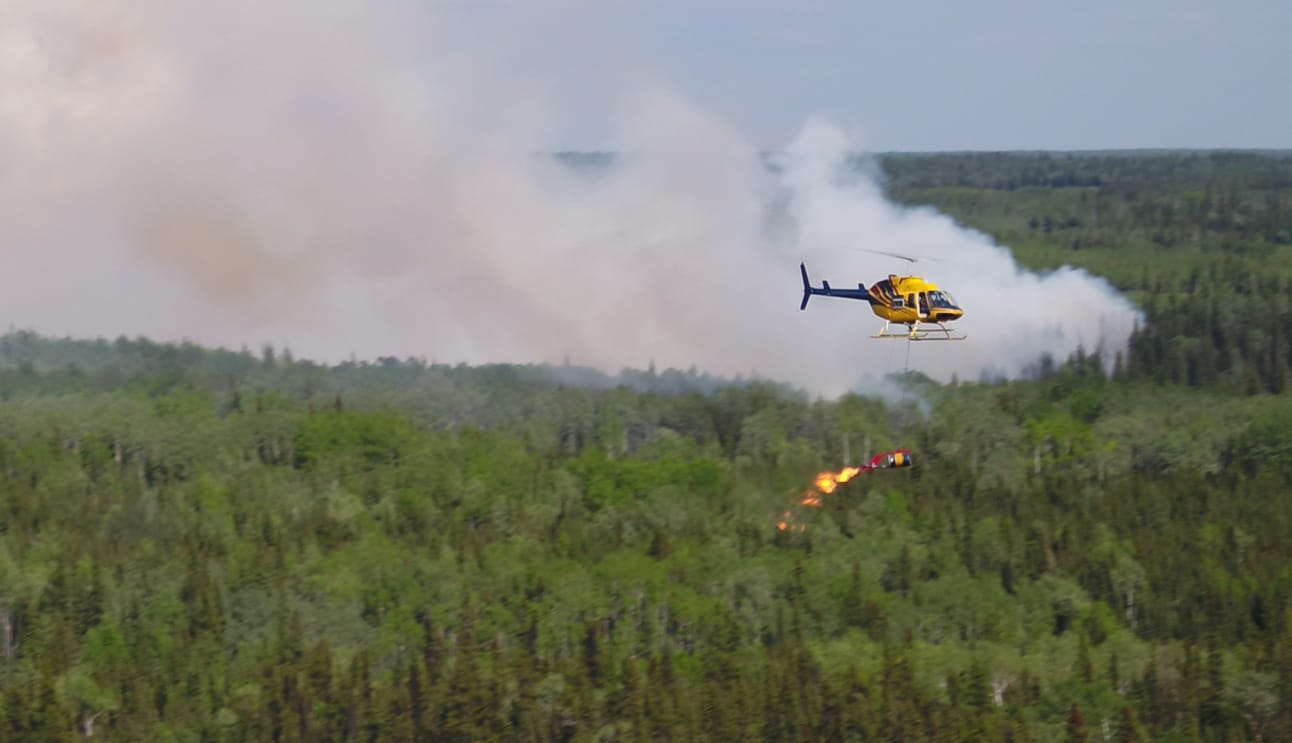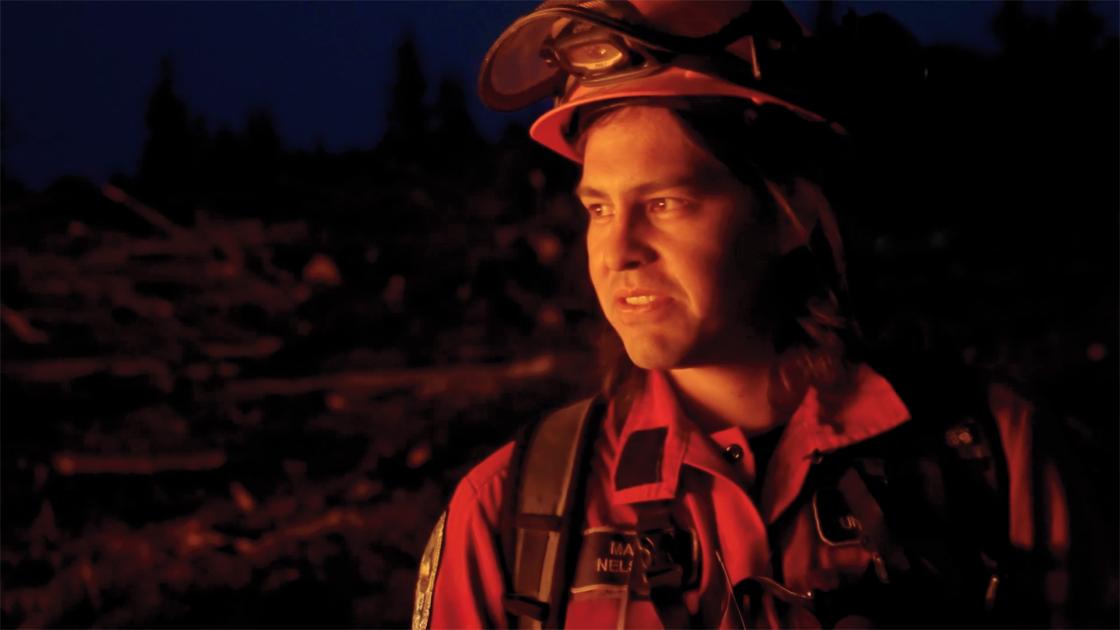- Fraser Valley Current
- Posts
- The heli-torch: the fiery tool in a wildfire helicopter pilot's arsenal
The heli-torch: the fiery tool in a wildfire helicopter pilot's arsenal

Fire crews use a device called a ‘heli-torch’ to create controlled burns that can limit wildfire spread. 📷 Photo courtesy CK9 Studios & Optic Nerve Films
You need a lot of tools to fight a fire. There are pumps, hoses, shovels, chainsaws helicopter buckets, weather satellites, and so on.
There is even something called “the red dragon”: a helicopter-borne device that drops incendiary ping-pong-like balls into a forest to start a controlled burn.
When documentary filmmaker Kevin Eastwood began shooting his five-part documentary for Knowledge Network, he was particularly (and perhaps predictably) excited to try to film the device in action. Instead, he got something even more spectacular: a blow-by-blow drama introducing viewers to a “heli-torch” and the crews that use the one-of-a-kind, hand-rigged machines designed to create large, precise burns to foil an incoming wildfire.
The heli-torch has a less-impressive name than the Red Dragon, but comes with an even better backstory. A heli-torch is essentially a hand-torch supersized to helicopter dimensions. Built in the off-season by some of the same pilots who will eventually navigate them in front of towering infernos, a heli-torch combines a 45-gallon fuel drum with a custom rigging that allows a pilot to drop fire in a precise line.
The fifth episode of Eastwood’s Wildfire series shows how technicians and pilots co-ordinated the creation of a massive controlled burn on the Donnie Creek wildfire in 2023. At a recent screening attended by FVC, Eastwood said the orignal plans had been to focus on the plastic sphere dispenser, but that the heli torch stole its thunder. Even then, it was unclear if crews would be able to fully capture its impact.
“We didn't really kind of know what that would be like until we got there. And we also didn't know if the footage was going to work,” he said. “A lot of it is just GoPros that we've fixed on things. So you kind of don't know what you get until you you get it back, and then it's like, ‘Oh, wow!.” It’s even more of a visual than just ping-pong balls that are dropping, which we thought was wild when we first heard about it, but it was kind of upstaged by the actual heli-torch.
Wildfire takes viewers to a range of locations in the 2023 fire season and profiles a series firefighters tasked with trying to mitigate the damage from that year’s massive blazes. Eastwood’s two co-creators, Clay Mitchell and Simon Shave, were former firefighters and helped the crews gain unprecedented access on the front lines. Among those they profiled was Mike Morrow, one of just a half-dozen igintion specialists. As he was being filmed, he was also working to pass on his duties to his apprentice, Morgan Boghean.
Early In the episode, Morrow spoke about the plastic sphere dispenser and the way crews used aerial bombardments to start controlled back burns.
"We have many different ignition devices in our arsenal,” Morrow said. “The plastic sphere dispenser, also known as the red dragon, is the device that shoots out plastic spheres, which are basically the size of a ping-pong ball [and] used for ignitions.”
He continued: “It’s an exothermic reaction where the potassium permanganate, when it meets glycol, produces heat and will burn at up to 2,000 degrees. The machine spits the ball out. It drops from the helicopter onto the ground. Twenty to 30 seconds later, it will burst into flame and burn for approximately two minutes.”
The operation brings risks—but also a dose of adrenaline.
“It is fun to do because you’re flying in the back of a helicopter and you have the door off and you’re seatbelted in—you have the greatest seat in the house for when the fire actually gets going.”
Some operations demand a modern machine like the PSD. Others require something like the hli-torch.
"The PSD is better for when you really have to be gentle. For example if you’re in the forest and it’s really hot and dry conditions, we can use the PSD and hopefully keep the fire on the ground level.”
Morrow then takes the viewers through a recent burn in which a PSD-started fire torched ground-level fuel while leaving the tree canopy untouched.
“All it’s done is burn off the dead grass—really low impact,” he says. “It’s very low severity. It’s not your typical image of a forest fire where everything’s black from top to bottom, as far as the eye can see. In three weeks to a month, the burn we did here will be green like you can never believe.
“It basically resets the ecosystem to where it always likes to start from.”
In the documentary, the heli-torch makes its appearance when Morrow and Boghean are called to co-ordinate a massive controlled burn on the Donnie Creek fire—the largest in the province’s recent history.
After ground crews—including one profiled by the documentary crews—set one controlled burn on the ground, by hand, Morrow co-ordinates another ignition. He decides that this needed to be conducted by air, and with the use of a heli-torch.
“The heli-torch is inherently dangerous just by the fact you have a 45-gallon drum of fuel hanging below a helicopter,” he said. “It’s inherently risky, but everything we do is careful and methodical, and that’s how we can get this done without having any injuries.”
Morrow explains how the pilot, in consultation with the ignition experts, decide when and where to ignite the forest below. A large fire creates its own weather systems, and frequently suck air towards it. Wildfire crews take advantage of that behaviour, setting controlled igintions in front of the fire line. The manmade flames then burn back toward the advancing fire front. As the controlled fire eliminates fuel in advance of the controlled burn, crews monitor the line to prevent it from moving in the opposite direction, toward properties and structures.
The use of heli-torches are a made-in-BC solution to the needs of wildfire crews.
“Every one of these heli-torches is handmade. Every one of them is absolutely different,” Morrow explains. “Helicopter geniuses—pilots and engineers—build them in the hangars in the winter months.”
“New pilots coming in, a lot of them don’t want to be heli-torching, and it is a dying art in the aviation industry because it is pretty risky when you have a 45-gallon drum of gasoline hanging under the helicopter.”

Reply